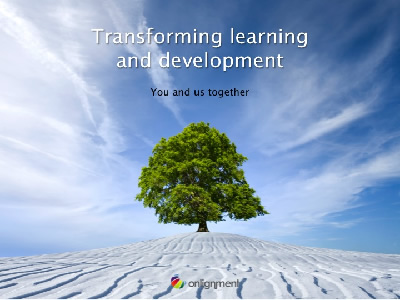![]()

In the first post in this series, we expressed a vision for learning and development that is aligned, economical, scalable, flexible, engaging and, above all, powerful in terms of the results it achieves. In this post, we look at the argument for l&d to be flexible.
Flexibility is an important element in the vision for a transformed l&d. What it implies is more control for l&d’s customers – the employees of an organisation. Adults expect to have control over what they learn, when and where and will increasingly demand it. They expect it because they have grown accustomed to finding whatever information they need at the click of a mouse from Google, YouTube and Wikipedia. Synchronous learning (that takes place with others, at a specific time, perhaps in a virtual classroom) can be powerful, but it is certainly not flexible. It means you have have to compromise on when you learn in order to suit others. Similarly, face-to-face learning can add a great deal of value when used for the right purposes, but is highly inflexible. Being face-to-face means you have to compromise on where you learn in order to suit others.
Flexibility can take many forms. For the learner it can mean:
- Controlling what you learn and to what level: So much traditional training is one-size fits all. Everybody starts and ends at the same place, regardless of need. But every learner is different in terms of their prior knowledge and goals, and it is not rocket science to organise training in a modular fashion. Providing this sort of flexibility is not always practical, but it should at least be an aim.
- Controlling how you learn: This is a tricky one, because there has been a lot of nonsense talked about learning styles and how different we are in how we like to learn, yet we are actually much more alike than we are different and it is usually uneconomical to offer training in alternative forms. However, there are sometimes obstacles that get in the way of learners taking advantage of a particular form of learning (disabilities, access to technology, inability to travel, etc.) and providing alternatives can be beneficial, if not compulsory.
- Controlling when you learn and at what pace: By and large, learners would prefer not to have to wait to learn something which is important to their work. They’d also like to control when they learn, for how long, how fast and how slow. Having to conform to someone else’s timetable is always going to be a compromise solution.
- Controlling where you learn: Having to travel to a central location for training is sometimes necessary, but is typically an expensive and time-consuming activity. If you can avoid it you should. It also makes sense to provide learners with the opportunity to continue their learning when they are on the move, so they can take advantage of the inevitable dead times on trains, in airports and hotel rooms.
Of course it can be extremely difficult to provide all this flexibility without impacting heavily on our other objectives of scalability and economy – we have to strike the right balance. But flexibility is a worthwhile target to have in mind and you can make big strides in this direction by creating more modular interventions, with a greater use of self-paced components, and by delivering online when possible.
Coming next: The vision: 5. Learning and development that is engaging





